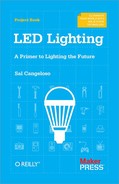Whether or not LED bulbs make sense today is a judgment call that every person and business must make for themselves. A higher initial outlay has to be justified against future savings, both in terms of electricity saved and replacement costs. To some, it will seem obvious that LED bulbs are the way to go, while others will be happy to keep buying cheap incandescents as long as they are available. Stepping away from individual judgement calls, do LED bulbs make sense today?
There are three main factors to take into consideration before choosing to go the LED route: initial costs, power savings, and replacement costs. By tabulating these, every person, business, and organization should be able to figure out the the best option for them.
Initial cost is what holds most people and organizations back from buying a more expensive bulb. They see the incandescent bulb that has always worked for them, which is also the least expensive option, and the one that matches the rest of the bulbs they use, so it seems like the obvious solution. As CFL prices dropped, consumers were able to justify the extra expense thanks to their clear labeling about power savings and longer lives, but the mercury warnings have proven enough to turn many people off.
With today’s LEDs, people see bulbs that range from $20–$40 and immediately write them off, knowing that the purchase of a single solid-state bulb would get them enough incandescents to illuminate their entire home for years. LED packaging clearly states the longevity and efficiency of the bulbs, but neither number is easy to understand. For instance, the 25,000-hour lifespan is not a term that is easy to take in and it’s also one that can be hard to believe, especially by people who were burned by short-lived CFLs. Even if people comprehend the length of 25,000 hours (about 8.5 years of life if you use a bulb for 8 hours a day, 365 days a year), who is thinking that far into the future? The average person in the United States is said to move every 5 years…are they going to take their bulbs with them when they go? The prospect of long-term savings is easily defeated by short-term desire to skip a considerable expenditure.
First-generation LED bulbs might have done more harm than good for the industry, at least for the consumer segment of the market. These products, as previously mentioned, were expensive, were often not dimmable, and had blueish lighting that made people feel as if they were in a hospital or government building. These bulbs had the unfortunate effect of turning people off from a new category of product that just happened to have been released too early for mainstream buyers. Even the people that bought and liked them saw the rapid progress of LED bulbs and might wish they had waited another year or two before making the investment—especially considering that their bulbs had years of life left in them.
The next big factor in a purchase is power savings. It’s one thing to read that LEDs use less energy than the competition, but the savings generated is much less easy to comprehend. How much will the total energy savings derived from efficient lighting actually mean when it’s in a bill combined with your refrigerator, dryer, and air conditioner? Your bill could be a few cents less each month, maybe a few dollars if you have a larger home, but it’s probably not going to be enough to make a considerable change. This is different for a business with dozens or hundreds of lights that run continuously, but even those savings will have to accrue over time before the bulbs buy themselves back.
The packaging and literature provided with LED bulbs often explains the savings over the life of a bulb given a set price of power (say, $0.11 per kilowatt hour) which can often be over $100, but that number is easy to dismiss. A yearly savings amount or buy back timeframe (the point at which an LED bulb will become the cheaper option than an incandescent would be) is helpful, but it’s difficult to convince people about savings when the initial price is higher. After all, casual consumers just want to decrease their initial bill and savvy ones fully understand the opportunity cost of investing that money in expensive lighting instead of something else. Regardless, the purchase does make sense from a power savings standpoint, it’s just a matter of whether you will keep the bulbs long enough that they will be able to give you a worthwhile return on investment.
Lastly, there is the often forgotten matter of replacement costs. This factors in not only the life of the bulbs (considering that you might need ten incandescents or three CFLs to match the life of an LED bulb), but also that bulbs are often in inconvenient places. If you need to rent a ladder or pay a person to switch a bulb, that cost should be taken into consideration. This is often more of a factor for businesses, but people with high ceilings would do well to take it into account.
Using these factors, it should be relatively straightforward to determine whether LED bulbs make sense for you or your business. Many people don’t like to mix bulbs, but upgrading from room to room might make sense. Selective upgrading might be worthwhile as well—just changing the lights that you use the most or that you leave on the longest, so that you can save money without spending hundreds on bulbs. Regardless of your methodology, it’s worth understanding that today’s LED bulbs save money over the long run and they are a big step up from what was offered just a few years ago. That doesn’t mean they are the correct choice for everyone or under all circumstances, but they are getting closer and closer to that point.
